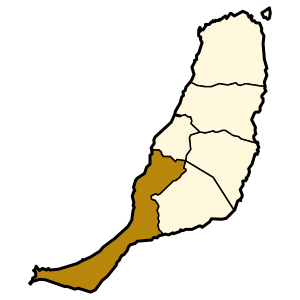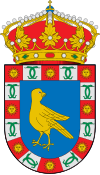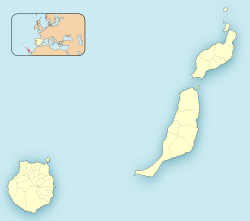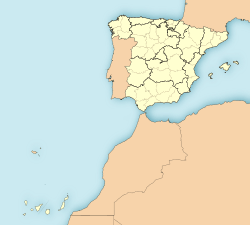Pájara facts for kids
Quick facts for kids
Pájara
|
||
|---|---|---|
|
Municipality
|
||
 |
||
|
||

Municipal location in Fuerteventura
|
||
| Country | Spain | |
| Autonomous Community | Canary Islands | |
| Province | Las Palmas | |
| Island | Fuerteventura | |
| Area | ||
| • Total | 383.52 km2 (148.08 sq mi) | |
| Elevation
(AMSL)
|
196 m (643 ft) | |
| Population
(2018)
|
||
| • Total | 20,539 | |
| • Density | 53.5539/km2 (138.704/sq mi) | |
| Time zone | UTC+0 (CET) | |
| • Summer (DST) | UTC+1 (CEST (GMT +1)) | |
| Postal code |
35628
|
|
| Area code(s) | +34 (Spain) + 928 (Las Palmas) | |
| Website | www.pajara.es | |
Pájara is a cool place on the southwestern part of Fuerteventura island. It's in the Canary Islands, which are part of Spain. Pájara is both a town and a whole area (called a municipality). It's the biggest area on Fuerteventura, covering about 383.52 square kilometers.
Around 20,539 people live in Pájara (as of 2018). It's the southernmost and westernmost municipality on the island. Some of the biggest towns in Pájara are Morro Jable and Costa Calma, both found right on the coast. You can also find the small port of Ajuy in the north, close to Betancuria. The Jandía peninsula is also part of this municipality.
Contents
How Fuerteventura Was Formed
Fuerteventura is the oldest island in the Canary Islands. It started forming about 20 million years ago from a volcanic eruption. Most of the island was created around 5 million years ago. Since then, wind and rain have slowly shaped it.
Scientists have found a huge piece of rock, about 22 kilometers long and 11 kilometers wide, on the seabed off the west coast. It looks like it slid off the island a long time ago. This is similar to what might happen in the future with a fault line called Cumbre Vieja on another Canary Island, La Palma. The last time a volcano erupted on Fuerteventura was between 4,000 and 5,000 years ago.
The highest point on Fuerteventura is Pico de la Zarza, which is 807 meters tall. It's located in the southwestern part of the island. Another interesting feature is Istmo de la Pared, which is 5 kilometers wide. This is the narrowest part of Fuerteventura. The island is split into two main parts: Maxorata in the north and the Jandía peninsula in the southwest.
Beautiful Beaches of Pájara
Fuerteventura is famous for its amazing beaches! It was even chosen as one of the best places to visit in Europe by a group called the Quality Coast International Certification Program. They picked it because of its interesting history, beautiful environment, and how it works to be sustainable. This means it's a great spot for visitors who care about nature and culture.
The Church of Nuestra Señora de Regla
In Pájara town, you can visit the church of Nuestra Señora de Regla. This church has some really cool carvings above its main entrance. You can see designs of the sun, snakes, panthers, and birds. Some experts think these carvings might show Aztec influence, which is pretty unique for a church in Spain!
See also
 In Spanish: Pájara para niños
In Spanish: Pájara para niños






